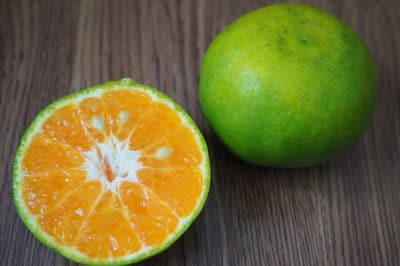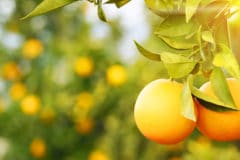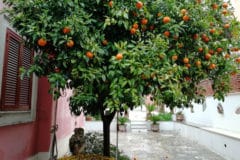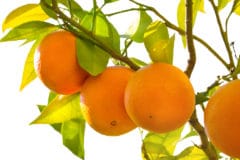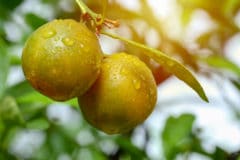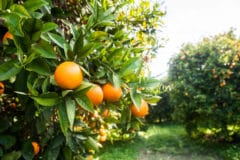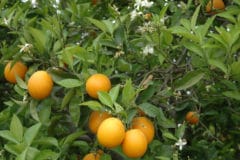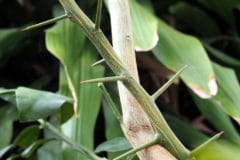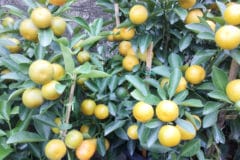Oranges’ Origins
The sweet orange trees (Citrus sinensis) familiar to us all are hybrids descended from Moroccan tangerine trees (Citrus tangerina) and Malaysian pomelos (Citrus maxima). They grow in tropical or subtropical climates, like those in parts of USDA plant hardiness zones 9 through 11. Thirty percent of commercially grown oranges come from Brazil.
U.S. Orange Production
In the United States, commercial orange growers are concentrated in:
- Florida
- California
- Texas
- Arizona
Most of Florida’s crop goes to the juice market. The other three states provide fresh oranges that are almost always picked and shipped when green.
What Makes Oranges Green?
Orange rinds contain two pigments: green chlorophyll and orange carotenoids. When they’re expose to temperatures below 55°F (12.7°C) for long enough, the green chlorophyll breaks down and the orange carotenoids surfaces in a process called “degreening.” In tropical countries, orange rinds may be permanently green – even when completely ripe.
Expert gardener’s tip: A tree’s age and the size of its crop may also influence how quickly its fruit degreens. The color change occurs fastest on younger, heavily bearing trees.
Artificial Degreening
Florida’s Navel oranges are sweet and juicy enough to harvest in October. But the cold nights they need to degreen usually don’t arrive until mid-December. The only solution is to pick the green fruit and degreen it artificially at processing plants before shipping it to market.
Like all citrus, oranges stop ripening as soon as they’re picked. So the color change they undergo at the processing plants is strictly cosmetic.
The Ethylene Gas Transformation
The degreening takes place in special rooms with temperatures between 82° and 85°F (27.8° and 29.4°C) and 90- to 95-percent relative humidity. A small amount of ethylene gas released into the air degrades the peels’ chlorophyll until their color is the sunny orange we’ve come to expect.
The Dye Job
As an alternative to ethylene gassing, the FDA allows any ripe, green oranges not intended for processing to have their rinds dyed orange with Citrus Red #2. The catch is that their labels or displays must clearly let the customers know they’re artificially colored.
Valencia Oranges and Regreening
Every rule has its exceptions, and in this case the honor goes to Valencia oranges (Citrus sinensis ‘Valencia’). Besides accounting for most of the U.S.’ commercial crop, Valencias are the only summer-ripening oranges.
Even after they degreen from the cold, growers often leave Valencias on the tree for another six months. When exposed to the spring and summer sun, their rinds start to reabsorb chlorophyll and turn green. Their pulp, however, gets even juicier and sweeter. This is the “regreening“ phenomenon.
To confuse matters even more, Valencia orange trees flower and set their fruit in spring. This means they’re loaded with double crops of fruit. When the older crop starts to regreen and the newer one start starts turning orange, telling them apart is a serious challenge.
